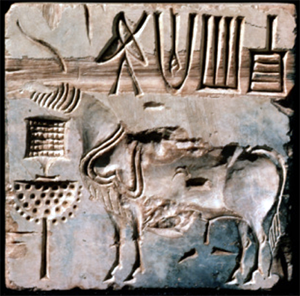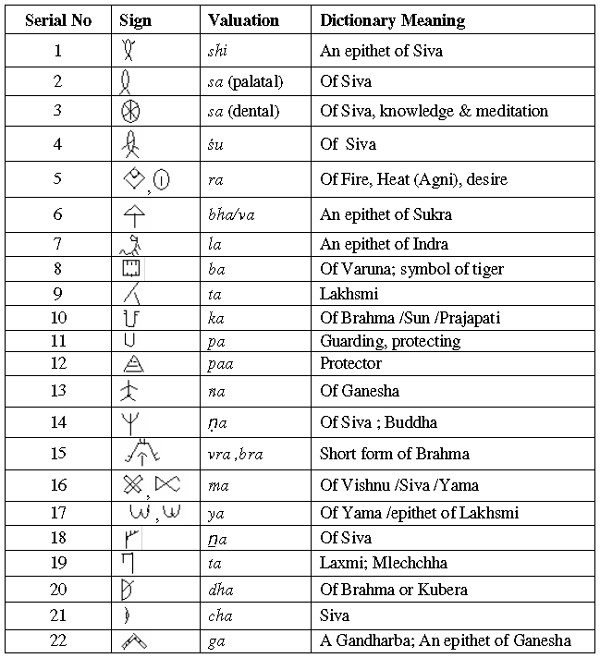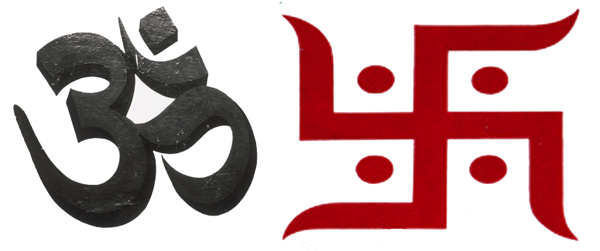Apr 16, 2024
Apr 16, 2024
by Rajat K Pal
Continued from "More on Decipherment of Indus-Saraswati Script"
 Many of the Indus seals have a distinct feature where in the text a short vertical or two short vertical strokes are found (sign like
Many of the Indus seals have a distinct feature where in the text a short vertical or two short vertical strokes are found (sign like ![]() , and
, and ![]() ). In some texts four cornered strokes (
). In some texts four cornered strokes ( ![]() ) are there. These signs distinctly separate one or more signs from some texts to others. These signs are identified as determinatives.
) are there. These signs distinctly separate one or more signs from some texts to others. These signs are identified as determinatives.
To explain the meaning of them the earlier thinkers opined these marks as below:
Types of Determinative Signs
Following types of determinative signs are found in Indus Script:
1. One short vertical stroke after one sign from the right side
2. Two short vertical strokes after one sign from the right side
3. Short vertical strokes after 2, 3 or 4 signs from the right side
4. Simple determinatives with four strokes beside the four corners
5. Short stroke in the middle of signs
6. More than one determinatives
My Explanation
Single Letters & Their Lexical Meanings
(Meaning taken from Sanskrit-English dictionary, compiled by Monier-Williams. Also consulted the dictionary by Vaman Shivram Apte)
Researchers often find it difficult to get the meaning of the use of single signs in some inscriptions. Almost 170 such inscriptions are found. After determining the valuations of some Indus signs in the light of Indo-Aryan Language we can have the dictionary meanings of single Sanskrit letters and from that we can decide the reason of using those single signs. This possibility was first thought by B.B. Chakraborty 30 years ago.
Reasons:
The reasons to use single letters are the following:
Methods:
To get the meaning of single letters I have followed the understated methods.
1. Determined the valuations of Indus-Saraswati signs.
2. Added vowel signs wherever required.
3. Put the dictionary meanings.
The use of a phoneme through a single letter to describe something special is an old Indian practice. The use of ‘aum’ sign or ‘swastika’ sign is one or two of the examples of them. Swastika sign has its root in the Indus-Saraswati civilization. Many of those Indus-Saraswati signs were accepted by the Vedic people and some others were invented by them. Almost all the Vedic /Sanskrit /Devnagari /Indo-Aryan phonemes / letters had specific meaning. From the above mentioned two dictionaries (Monier Williams, 1st published from London in 1899 and Apte in 1965) I have taken the meanings of single letters to establish that those single letters have long past significances.
Single Letters Used by Indus-Saraswati People
and Their Lexical Meaning

Table
I want to produce some other meanings of letters used by Vedic people, but not found in Indus-Saraswati civilization. Especially vowels were not used by Indus people independently.
Letters Not Found in Indus-Saraswati Script
but Used by Vedic People
.png)
Table
Note:
Vowels were not found in use independently in Indus-Saraswati script. The lexical meanings of all vowels are related to Vedic cultures. It can be decided that the signs of those letters (vowel) were later invented by the Vedic people and put their cultural meanings on them. We should not forget that Indus-Saraswati people were not purely Vedic people, but Vedic cultures were not unknown to them.
There existed dynasty who were the believers of Vedic cultures (at least Atharva Veda) in one or other forms in the Saraswati River valley. To them the Vedic gods were very much known. We should not forget that those gods were known to the Hittite people of Middle East also.
From the Indus-Saraswati list we found the sign of ‘va’ which is ‘an epithet of ‘Sukra’ and from the rest list we get ‘jha’ which means ‘Brihaspati’. Hindu mythologies say that Sukra was the Guru of Asura-s and Brihaspati was the Guru of Deva/Sura-s. So the use of ‘va’ sign by Indus-Saraswati people and ‘jha’ by Vedic people can be explained properly.
From the names of gods we get the maximum uses of the name Siva, who was regarded as Pasupati or Maheswara. The common pictures of god Pasupati found in that areas are hereby attested.
I have found an interesting lexical meaning of the phoneme ‘ksha’ which means ‘a demon or Rakshas’.
Lord Siva was no doubt regarded highly by Indus-Saraswati people. Mythologically Sukra was the guru of Asura-s. Varuna was one of the head gods at the Rig Vedic period, but later degraded by the Sura/Deva-s. Varuna was worshipped by other Vedic Aryan sects. Like the Persian (Avestan), Indus people had their regards for Varuna. Ganesha, the son of Lord Siva was regarded a lot by them. In present days Ganesha is the prime god at western part of India, where festival like ‘Ganapati Utsab’ is observed. On rare occasion names of gods like Indra and Laxmi are taken. The Devi of cultivation might be somewhere synonymous to Laxmi. All those single letters reflect the composition of the society I want to establish.
These single letters are used with the belief that the said gods would protect them and their belongings.
Often those letters were used with one or two upside strokes (we state them as ‘determinatives’), which separate them from the main texts. Like every rule this case also has exceptions when those single letters were used without determinatives.

Aum Swastika
Those two signs (Aum & Swastika) have been used for hundreds of years by the Vedic as well as Hindu people. Indus-Saraswati people used the Swastika sign. Like aum the Swastika had a special phonetic value which was known to the Indus-Saraswati people, but unknown to us.
Single letters (often ligatures like aum = a+u+ma by Vedic people and ksha= ka+sa by Indus-Saraswati people) were in practice as titles or devotional reasons for a long time. In case of Harappan people the use of single letters separately and with other names are found abundantly.
The Indus tablets may have used as tokens, made up in advance and distributed when goods were brought into the city as tribute or sale – J.M.Kenoyer,1998
Many ancient scripts employ special sets of signs, known as determinative, which are not pronounced when inscriptions are read – B. Wells, 1998.
Previous: "More on Decipherment of Indus-Saraswati Script"
09-Sep-2012
More by : Rajat K Pal

|
many history researchers found that vedas were written sometime around 3000 to 3500 years back. however the indus valley civilization was somewhere 4600 3900 years back. More so vedas were originally not written scriptures. They spread from mouth to mouth and took a script form only sometime just around 2500 years back most likely in the script of brahmi or its derivatives subsequently like nagari, pakruti etc so there was huge time gap between indus valley civilization and vedas as such these jpeople might not have any knowledge over indra, varuna, agni ,kubera, yama etc. these were brought only by aryans. and some more gods were there for local natives of india (who were later driven down to forest infested south and eventually called dravidians). For the above reasons it may not be possible to look for single syllble meanings. There are plenty of such meanings available in Ekakshiri Naghantuv. We can not attribute these meanings to the symbols, pictures and script used by indus valley people. There mustbe some other wirtten or spoken form of lanugage underlying these symbolic pitcotrial language of indus valley. |

|
jj sir, determinatives are found in many ways, like one short stroke, two short strokes, four strokes around a letter etc. this style of writing even found in Brahmi era. this style was a continuation from Indus, I presume. longer strokes have a unique feature. those strokes are found from 'one to twelve' in different seals and then only 24 strokes at a time. without the numerical values I could not took them in other meanings. at the time of Brahmi era the first three numbers i.e. 1.2.3 were used by one, two, three strokes respectively. for bigger numbers stroke-method was abandoned, as words/signs for numbers were evolved then and those words/signs instead of strokes took lesser space and effort for writing. regards rajot |

|
The two short strokes, then, are all 400+ determinitives and the longer strokes actual numbers? What brought you to this idea? Many blessings |

|
thanks a lot. |

|
An excellent article - an original research work - deserves to be published in some journal on linguistics. It is very gratifying that a bureaucrat today engages himself in such scholarly pursuits. |